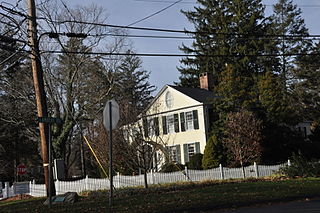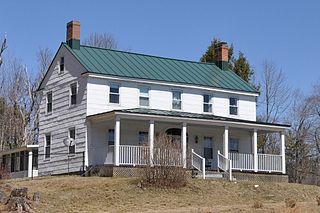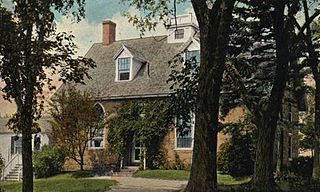
The Gardner–Pingree House is a historic house museum at 128 Essex Street in Salem, Massachusetts. It is judged to be a masterpiece of Federal architecture by the noted Salem builder Samuel McIntire, and was designated a National Historic Landmark in 1972 for its architectural significance. It is owned by the Peabody Essex Museum as part of its architectural collection, and is open to the public for guided tours.

The Nathan Wood House is a historic house located in Westminster, Massachusetts. Built in 1756 by one of the town's early settlers, it is one of its oldest surviving buildings, and good example of colonial Georgian residential architecture. It was listed on the National Register of Historic Places on September 16, 1987.

The Whitaker-Clary House is a historic house in New Salem, Massachusetts, United States. It currently houses the museum of the Swift River Historical Society. Built about 1816, it is a fine local example of Federal period architecture, and was listed on the National Register of Historic Places in 1975.

The Capt. Charles Leonard House is a historic house at 663 Main Street in Agawam, Massachusetts. Built in 1805, it is described as Agawam's finest Federalist building, and is attributed to architect Asher Benjamin. It is now owned by a local nonprofit organization, which uses the house to stage community events. It is open for tours, and is available for rental. The house was listed on the National Register of Historic Places in 1975.

Fort Sewall is a historic coastal fortification in Marblehead, Massachusetts. It is located at Gale's Head, the northeastern point of the main Marblehead peninsula, on a promontory that overlooks the entrance to Marblehead Harbor. Until 1814 it was called Gale's Head Fort.

The Roswell Butler House is a historic house on Upper Main Street in Essex, Vermont. Built about 1822 with later alterations, it is a good local example of Federal period architecture. It was built for Roswell Butler, a prominent local businessman from whom the surrounding Butler's Corner neighborhood takes its name. The house was listed on the National Register of Historic Places in 2001. It is also known as the 1820 Coffee House and the Kilmoyer House on the Essex Vermont town list of historic sites.

The William Pinto House, also known as William Pinto-Eli Whitney House, is a historic house at 275 Orange Street in New Haven, Connecticut. It is a Federal-style building of post-and-beam construction, and was built in 1810 for John Cook, a merchant. It is rare and unusual for its design, which places the gable end facing the street, rather than to the side as was more typical in the Federal period. It is historically notable for its second owner, William Pinto, a member of one of New Haven's leading Jewish families, and for its third occupant, Eli Whitney, who leased the house from Pinto in the later years of his life. The house was listed on the National Register of Historic Places in 1985. It now houses professional offices.

The Hanford Davenport House, also known as the Davenport-Green House, is a historic house at 353 Oenoke Ridge in New Canaan, Connecticut, United States. It was built in 1820. It was listed, along with a 19th-century barn on the property, on the National Register of Historic Places in 1989. The house is significant as a fine example of Federal architecture and features especially high quality Adamesque carving in its interior.

The Josiah Cowles House is a historic house at 184 Marion Avenue, in the Plantsville section of Southington, Connecticut. Built in the mid-18th century, it is a well-preserved local example of Georgian architecture. It was listed on the National Register of Historic Places in 1989. It presently houses a bed and breakfast inn.

The Jared Cone House is a historic house at 25 Hebron Road in Bolton, Connecticut. Probably built around the turn of the 19th century but also including an older ell, it is one of the rural community's finest examples of Federal period architecture. It was listed on the National Register of Historic Places in 1990.

The Capt. Samuel Allison House is a historic house on New Hampshire Route 101, overlooking Howe Reservoir, in Dublin, New Hampshire. Built about 1825 by a locally prominent mill owner, it is a good local example of Federal style residential architecture. The house was listed on the National Register of Historic Places in 1983.

The Hewitt House is a historic house on United States Route 4 in Enfield, New Hampshire. Built in 1871, it is a particularly fine example of late Italianate architecture, built for the manager of local woolen mills. The house was listed on the National Register of Historic Places in 1985, and included in the Enfield Village Historic District in 2010.

The Sawyer–Medlicott House is a historic house at the junction of Bradford and River roads in Piermont, New Hampshire. Built about 1820, it is a good example of Federal period architecture, and the only brick house of that style in the small town. It was built for Joseph Sawyer, a real estate speculator and politician. The house was listed on the National Register of Historic Places in 1991.

The Capt. John Gunnison House is a historic house on Goshen Center Road in Goshen, New Hampshire. Built in 1812, it is one of the town's finer examples of Federal architecture. It was the childhood home and likely birthplace of John Williams Gunnison, a military officer who led exploratory expeditions in Colorado. The house was listed on the National Register of Historic Places in 1979.

The Gen. John Williams House is a historic house at 62 High Street in Bangor, Maine. Built in the early 1820s, it is believed to be the oldest brick house in the city, and one of its only examples of Federal architecture. It was built by John Williams, a leading businessman and militia commander of the period. The house was listed on the National Register of Historic Places in 1978.

The Governor William King House, also known locally as the Stone House, is a historic house on Whiskeag Road in Bath, Maine. Built in 1812, this stone house's lancet-arch windows are one of the first examples of Gothic Revival architecture in New England. The house was built as a summer retreat for William King, who led the drive for Maine statehood, and served as the state's first governor. The house was listed on the National Register of Historic Places in 1976.

The Augustus and Laura Blaisdell House is a historic house at 517 Depot Street in Chester, Vermont. Built in 1868 for a local businessman, it is a fine local example of transitional Greek Revival-Italianate architecture. It has historically served both commercial and residential functions, and now contains apartments. It was listed on the National Register of Historic Places in 2014.

The Wiscasset Historic District is a 101-acre (41 ha) historic district that encompasses substantially all of the central village of Wiscasset, Maine. The district includes at least 22 contributing buildings and two other contributing sites, one being a cemetery whose oldest stone is from 1739. Located on the west bank of the Sheepscot River and settled in the 18th century, Wiscasset was a prominent harbor in Mid Coast Maine, and a major shipbuilding and merchant port, until the War of 1812 ended its prosperity. The village center includes fine examples of Federal period architecture, most built between about 1780 and 1820, including one National Historic Landmark, the Nickels-Sortwell House. The district was listed on the National Register of Historic Places in 1973.

The David Sumner House is a historic house at 4 Station Road in Hartland, Vermont. Built about 1807, it is a fine local example of Federal period architecture, exhibiting the influence of architect Asher Benjamin. It was built for David Sumner, a major local landowner and operator of sawmills. The house, now the Sumner Mansion Inn, was listed on the National Register of Historic Places in 1989.

The William Moore Jr. House is a historic house at 5 Mountain Road in the Riverton village of Barkhamsted, Connecticut. Built about 1820, it is a good local example of Federal period architecture in brick, and is notable for its association with the Moore family, where both the father and son were involved in the early chair-making trade for which Riverton is well known. The house was listed on the National Register of Historic Places in 1999.
























